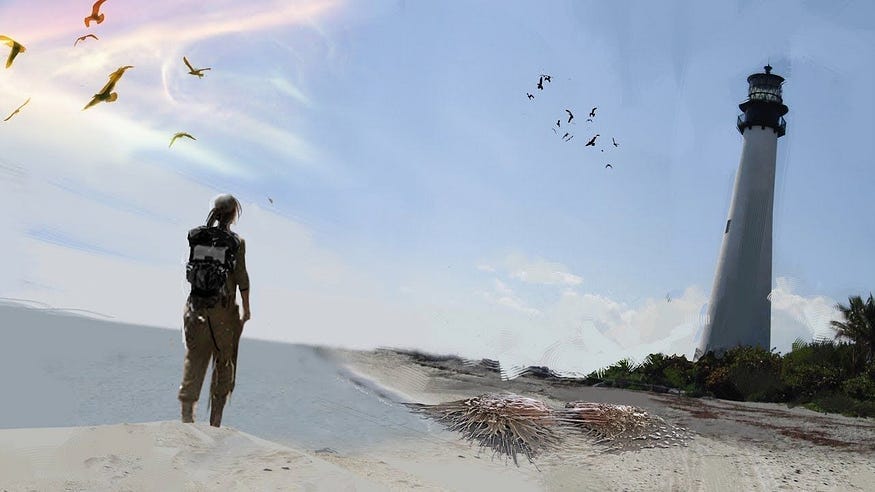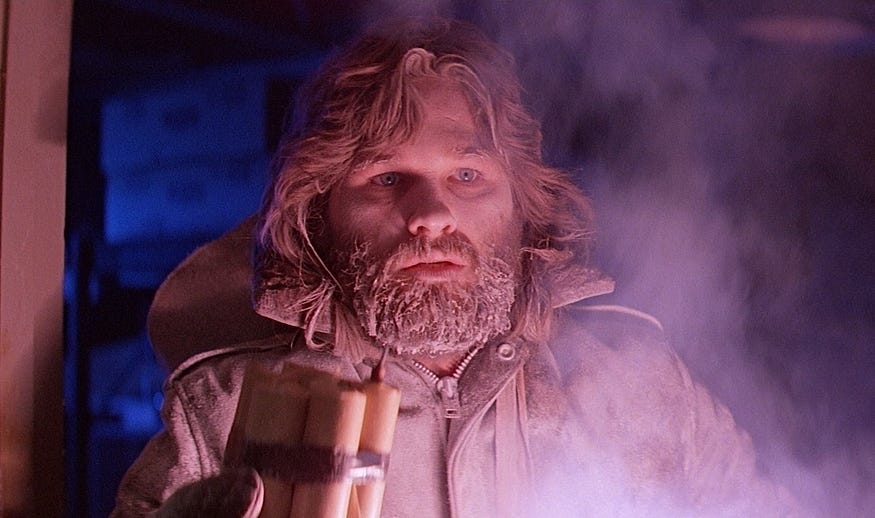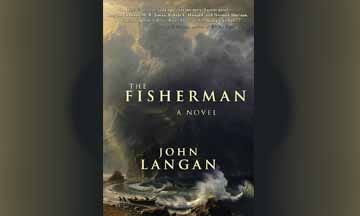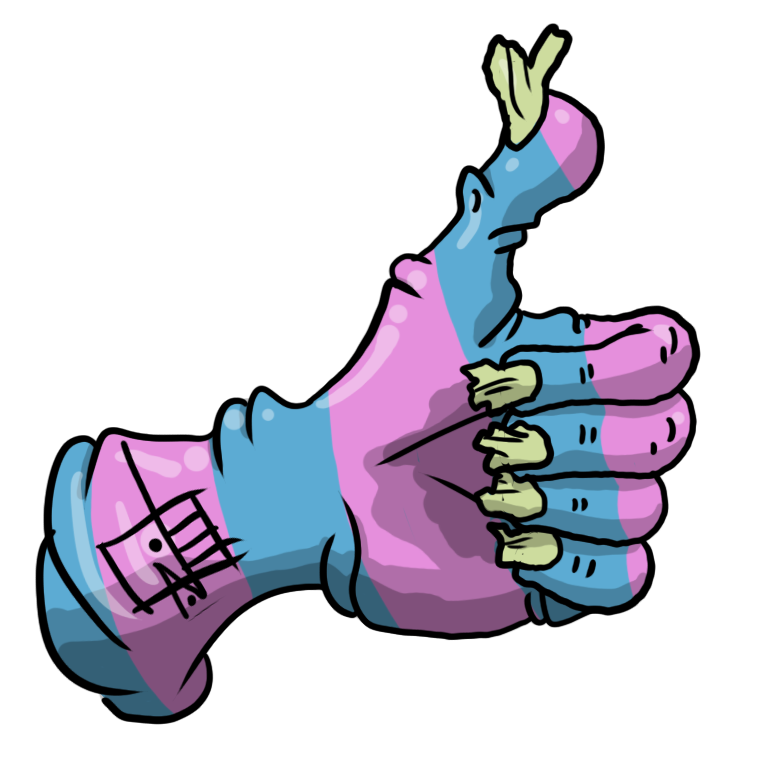And Another Thing: Comfort In the Abyss — The Hygge of Cosmic Horror
An essay of tentacle-brained hypotheses
Greetings newsletter friends! There’s a new Finishing School on the way, but I thought I’d offer some other nonsense in the meantime. I wanted to inject some variety into the offerings in the newsletter, so alongside the usual blatherings, I’ll occasionally send over another thing — fiction, art, animation…stuff. This time, it’s a tentacle-brained essay I wrote about how cosmic horror is, in fact, cozy.
Enjoy?
I mean, enjoy!
Comfort In the Abyss — The Hygge of Cosmic Horror
It’s difficult to overstate just how important the concept of home is. More than just the four walls with which we surround ourselves, it’s a collection of people and memories, wrapped up in emotions that give us a sense of safety. Sometimes it’s a space devoid of people, offering sanctuary from the chaotic collection of voices, opinions, smells, and flailing limbs that seem to saturate the outside world. It’s our unique form of coziness. Every time I move to a new city or country, the reason for moving, really, is that I’m still trying to find home.
As difficult to quantify and individualized as home can be, we know it when we feel it.
Which is why feeling it in an unexpected place can give us pause.
This happened to me recently. I was working in a job I found incredibly stressful and I sought an escape from the inevitable impending burnout by unwinding with a video game. Now, I wouldn’t call myself a gamer, and I immediately become lost in conversations on the subject that take place outside of a very niche set of titles. Nevertheless, I reasoned that gaming was a pretty good way to just switch off.
After a little while, though, I realized I wasn’t returning to the same game for a couple of hours every night because of the gameplay (at least, not entirely). Rather, each time I returned to the world and the atmosphere of the game, it genuinely felt like I was going home.
The game was Sunless Sea, by indie developer Failbetter Games. A spinoff of the studio’s text-based adventure, Fallen London, this isn’t the type of cozy farming sim populated by cute animal characters that — let’s be honest, here — you wouldn’t mind punching in their furry faces. It is an alternative history cosmic horror, in which one takes to the titular sea amidst a desperate kind of human existence. Crates of souls are tradable goods and an archipelago is populated by spiders that inhabit emptied human eye sockets.
Sounds bleak, right? It is…and yet, I found it cozy. The design is washed in a chilling phthalo green, nevertheless each time I took my ship out to sea, I felt wrapped in a warm blanket of impending horrors.
Yes, yes; these are contradictions, I know. To seek out the tropes of existential terror as not just a source of catharsis but to embrace its womb-like comfort is deeply odd. Yet, here it was. Inescapable as a tentacle from the void, the realization that it wasn’t necessarily the game that was home, but the reliable exposure to cosmic horror it offered.
The thing is, it sort of doesn’t matter where we find home. Unless of course we find home in the disemboweled contents of innocent victims…that sort of matters. But still, when you find something that inexplicably feels like home, it’s natural to want to dig a bit deeper. Not just to make it a little more explicable, but to maybe even figure out how you can get a bit more of that feeling.
Isn’t that worth exploring?
And so, I embarked on a little journey of discovery into the cold and damp wastelands to understand and achieve cosmic hygge.
Finding Familiarity in the Unknown
Something that occurred to me pretty early on is that this sense of home in cosmic horror might have something to do with a feeling of familiarity. After all, this is a hallmark of the coziness of home. Familiarity gives us a sense of safety in a world that can feel unpredictable and dangerous. Especially right now, many of us feel reality is less of a reliable home than it is a rabid and bucking mutant mongoose.
Sunless Sea, like so much of the cosmic horror genre — from Lovecraft’s The Shadow Over Innsmouth to 2018 movie Annihilation (based on Jeff VanderMeer’s Southern Reach trilogy) — has a form of seaside setting. Having grown up on the south coast of the UK, I feel a great connection with the damp and fishy environments of cosmic horror.
But is that all there is to it? I don’t think so. If it was, I probably wouldn’t have scarpered from the town I grew up in as soon as I possibly could. You know, there’s only so many times you can watch elderly folk respond violently to a lukewarm fish supper.
Diving deeper into the genre, revisiting the movies, tv series, and fiction, I find that familiarity lies elsewhere in cosmic horror and in far more significant ways. Its true setting is really the unknown. This isn’t the same as many other types of popular horror in which the character understands the concept of a haunted house or is equipping themselves in predictable ways as they set out to hunt a vampire. In cosmic horror, characters usually begin with no possible frame of reference for what they are about to experience. Even when they do come face-to-face with the object of horror, the fear is compounded by utter bafflement.
Sure, the unknown is intended as a source of fear but I would argue it’s also a source of familiarity. The stability of day-to-day life is an illusion. As alien as cosmic horror can feel, it is nothing more or less than a reflection of human existence. I’m not saying that we all open our curtains each morning and look outside to see tentacled beasts rising from the depths. That one might just be me. Still, every day is a step into the genuine unknown, decorated by a mutually agreed upon sense of what is normal. Introduce the detritus of cosmic horror and what is at the core of it is actually an exaggerated form of the familiar unknown.
And so, this is a way to connect to cosmic horror. Perhaps a little more so than other horror subgenres that have clear sets of rules and principles that are predictable in ways that don’t really reflect our experience.
Is being confronted by the unknown writ large necessarily pleasant? Of course not; it can be downright terrifying! That’s the point of it. At the same time, it is familiar; it is close to us, a universal experience. When watching Annihilation and reading China Mieville’s Kraken, something I now notice is that the unknown in these pieces isn’t really something I want to run away from. Instead, it draws me deeper in. I see myself in this unknown and — if I’m really honest — it’s something I quite appreciate about life itself.
Ehh…well. Most of the time. The unknown of politics, employment, health, social systems are all way more terrifying than the cosmic horror unknown.
Anyhow, if we’re looking at this genre as a potential source of hygge, the tropes of the terrifying unknown are actually a well-worn and somewhat domestic companion. Every time I dive in to a piece of this media it’s there, sitting in its dog bed across the room, panting in comforting yet unfamiliar patterns. Though its face is wrought from the torn fabric of the space between realities, it is still smiling at me as an old friend.
Reassuring Monstrosity
Well, okay, there’s a chance that the unknown contributes to the coziness of cosmic horror. That can’t be everything, though, right? After all, my electricity bill is familiar, but I don’t want to revisit that every evening, clutching it like a hot water bottle for comfort.
So, what else might contribute to this feeling of home?
The monsters, maybe.
If you’re screaming at your screen that the ever-present threat of monsters isn’t exactly the most comforting part of any horror, I’m not going to tell you you’re wrong. Cosmic horror definitely has its share of terrifying creatures, too. A lot of people today are familiar with Cthulhu, the gigantic, tentacled part-dragon, part-ape elder god from beneath the waves. Some of us even have slippers in the shape of his eldritch visage. There are also more abstract and arguably terrifying examples of monstrosity in the genre. For instance, Azathoth is the Blind Idiot God whose form defies description and — as it may well be dreaming our reality as we know it — being awoken from its slumber could spell armageddon for us all. Which is lovely, isn’t it?
Reasons though these might be to have haunted nightmares, there’s definitely something about them that contributes to cosmic horror’s hygge potential. At least, more so than creatures of traditional terror tomes and folklore. When we peek warily at the shadows in case of vampires or shudder when we hear loud buzzing because we might suddenly be confronted by Jeff Goldblum, it is because these monsters are after us. They choose us specifically to feed their hunger or to take vengeance upon. Traditional horror monsters tend to spell targeted persecution.
The monsters of cosmic horror, on the other hand, are usually almost entirely without malice. Sure, these terrifying and alien creatures from the depths of the Dreamlands have the potential to unmake us entirely, but it is not out of spite. Rather, it’s because we don’t matter.
Cool idea, but what cosmic horror backs up this harebrained and incredibly tenuous hypothesis?
Well, in John Carpenter’s The Thing, it’s clear throughout the movie that human (and occasionally canine) death happens because the titular being absorbs organic stuff indiscriminately, imitating its prey purely as a mechanism for its survival. To say this was malicious would be like saying we humans breathe because we harbor a species-wide grudge against oxygen!
Similarly, in Laird Barron’s novel The Croning, we’re told that the cosmic entity known as Old Leech actually loves humanity and the terrible things that will happen upon his awakening are just a different kind of love. Which…isn’t at all gaslight-y.
Generally, though, the only time anything close to malice occurs in cosmic horror in relation to these monsters is by the actions of humans; either in service to their ancient gods or attempting to bend such horrors to their will. It is the cults and the power-hungry billionaires we have to fear, not the ancient interdimensional horrors. Honestly, these are terrors we all live with every day.
But does the lack of malice in these monsters really contribute to the coziness of cosmic horror? Yeah, I think so.
There’s a coziness in the knowledge of our utter insignificance. In many ways, cosmic horror not just confronts us with the fragility of our mortal form but the reality that we as a species are miniscule. Even long after we are gone, the universe will continue without us and while we are here we can be swept away swiftly as a terror that’s not even on our radar wraps its tendrils around us and pulls us into the blackness of the cosmic deep.
The fact that we don’t matter at all is utterly freeing. It makes our day-to-day concerns — the genuinely stressful financial issues or work problems — feel like the blips in time that they are. Can you really worry about what your boss has to say about your project when somewhere a fallen meteor is terraforming our planet with whereupon it will soon be entirely uninhabitable by people?
In cosmic horror I get to snuggle down into a nest of my insignificance and sip deeply on the cocoa of our existential meaninglessness. I have these moments, these short pockets of time to relax, as what is coming across the cosmos is genuinely unstoppable. Importantly, it’s not driven by the hate we see increasingly frequently. Give me these most alien of monsters, please.
The Aesthetic of Loneliness in a Cold Universe
Okie dokie, so we have our monsters and the unknown to keep us warm in the long winter months. But the room is still looking a little too empty to genuinely feel like home. So, let’s grab a little decoration. The imagery of cosmic horror is among its most crystalline elements. While there’s a terrifying intangibility to these tales that makes it feel as though the ability to understand what’s happening is just outside our grasp, the imagery is something we can grab ahold of.
The thing is, so often in cosmic horror, these aesthetics project a kind of loneliness. How on earth (or any of its related dimensions) can anyone find this cozy? Well, there really is something about solitude that can be quite comforting. The aforementioned game of my recent addiction, Sunless Sea, incorporates a range of isolated surroundings—abandoned cities, vast oceans — that evoke a sense of tranquility amid the terror.
Yes, this is another way in which the genre emphasizes our insignificance in the universe and prepares us for the idea that we can be obliterated without the cosmos missing us. Yet the aesthetic of loneliness also provides an experience that goes beyond simple existential dread. It can be a reminder of the beauty that accompanies solitude. Weirdly, loneliness in the right setting allows fear to coexist with a sense of peace.
Rummaging around to discover some logic behind the coziness of the genre, I found that a great example of this aesthetic of loneliness is The Magnus Archives episode 159, The Last. The idea of isolation and its beauty is pretty central to the narrative of the piece, alongside contributing to its atmosphere. The protagonist, a member of the Lukas family, describes a life spent embracing solitude. His childhood memories include wandering the sprawling, empty grounds of his family estate and experiencing an early affinity for detachment. As he grows older, he finds solace in deliberately distancing himself from society, ultimately attempting to summon a horrific entity known as The Lonely by crafting a space that exemplifies solitude.
It might be over-intellectualizing (I assure you, I’m stumbling around and overthinking), but the sense of coziness sort of emerges from the tension between the fear of cosmic indifference and the soothing simplicity of being alone in the void. In fact, I’d say the protagonist of The Last finds that comfort comes not despite the existential dread, but because of it. There’s a quiet expanse he’s creating that probably makes room for meditation and peace, away from the clutter of messy human relationships. This makes the episode, dare I say it, aspirational in its horror.
The feeling of eerie and lonely peace is also captured in The Fisherman by John Langan. Like so many of the best cosmic horror pieces, the isolated aesthetics of the landscape itself becomes a character. The mountains and rivers of the Catskills are presented as silent and indifferent to human suffering, but they also offer a strange kind of solace. The protagonists are alone in the wilderness, surrounded by nothing but creepily whispering trees and quiet streams, which both provide tension to the growing fear while also offering a peaceful space to grieve. Yeah, the setting offers a peculiar kind of comfort, as we know that there are horrors waiting just beneath the surface. And yet, as a reader I found I could share in the solitude and feel as though — like the characters — I was connecting with something larger than myself.
So, what am I saying here? Well, it seems that in each of these works — and many others in the genre — the aesthetics of loneliness become a source of comfort and clarity within the horror. The vast emptiness of the universe we live in can be terrifying, but it also frees them from the constraints of everyday life. Yes, there is always a bleakness that contributes to the sense of terror, but I feel that it also offers sanctuary. In some instances, there’s even a tinge of envy at the characters’ opportunity to fully confront their place in the cosmos and — despite the horrors that surround them — reflect and in many ways give themselves over completely to the void even for a short amount of time.
This is something that feels like the ultimate sense of home and coziness to me; it gives you permission to just…be.
Conclusion — The Cosmic Search for Home
I realize — I really do — that this voyage of horrific hygge I’m taking myself on is basically having an argument of contradictions with myself. I’m wrestling ideas to try to justify an intangible feeling.
So why bother at all?
Well, if I can somehow intellectualize what it is about cosmic horror I find so comforting, then that can give me an insight into structuring the right components around myself. Like the concept of hygge, it might empower me to gather the elements that bring me a sense of deep warmth and incorporate them into a regular routine for myself. Perhaps I could even — as with writing this essay — share this knowledge with others and give them a chance to find home in an unexpected place.
So, what have we found might, perhaps, maybe contribute to the cosmic coziness?
Well, it’s gotta be lonely in the void. This means either spending these periods of decompression entirely alone or so completely burying myself in an atmosphere of cosmic horror that it’s a simulation of loneliness, even around others. A set of phthalo-tinted spectacles to bathe the lonely surroundings in additional bleakness might not go amiss either.
Confronting myself with the unknown ought not to be too challenging — it’s around us all every day. Though saturating my space with alien sounds and sights, eschewing the detritus of day-to-day predictability might help.
Vast and unknowable monsters, though? Well, maybe that’s about finding distractions from the all-too-human monstrosities we’re faced with every day.
Or perhaps…perhaps the only way to truly discover the home in cosmic horror is to exist in that narrative. Set out on a genuinely doomed arctic expedition or seek out cursed tomes that unlock portals to indescribably netherspaces sitting just beneath our reality. Even if I don’t discover cultists attempting to raise creatures from beneath the waves, there is a sense of hygge, of comfort, of home in dedication to that purpose, after all.
Then again, a couple of hours on a game every night might be a bit more achievable.
Thanks for reading and — as always — I’d love to hear your thoughts on And Another Thing, cosmic horror, and…sure, your favourite tentacles. Drop a comment below! It’d be really helpful, too, if you could follow the Victorian hand to the Share and Subscribe buttons.









